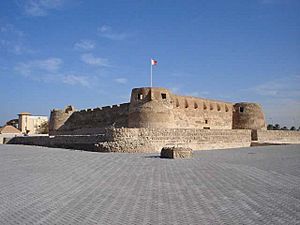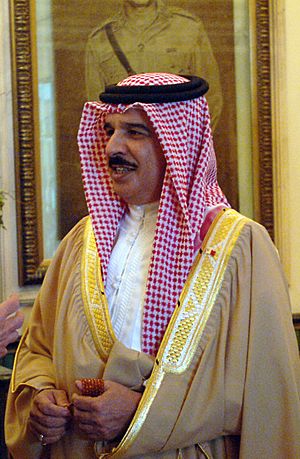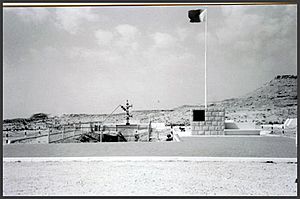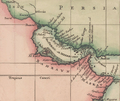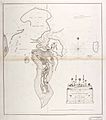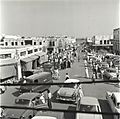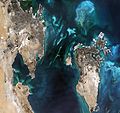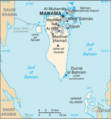Bahrain facts for kids
Quick facts for kids
Kingdom of Bahrain
|
|
|---|---|

Location of Bahrain (in green)
|
|
| Capital and largest city
|
Manama 26°13′N 50°35′E / 26.217°N 50.583°E |
| Official language and national language |
Arabic |
| Ethnic groups
(2020)
|
|
| Religion
(2021)
|
|
| Demonym(s) | Bahraini |
| Government | Unitary Islamic parliamentary semi-constitutional monarchy |
|
• King
|
Hamad bin Isa Al Khalifa |
|
• Crown Prince and Prime Minister
|
Salman bin Hamad Al Khalifa |
| Legislature | National Assembly |
| Consultative Council | |
| Council of Representatives | |
| Establishment | |
| 1783 | |
|
• Declared Independence
|
14 August 1971 |
|
• Independence from United Kingdom
|
15 August 1971 |
|
• Admitted to the United Nations
|
21 September 1971 |
|
• Kingdom of Bahrain
|
14 February 2002 |
| Area | |
|
• Total
|
786.8 km2 (303.8 sq mi) (173rd) |
|
• Water (%)
|
negligible |
| Population | |
|
• 2018 estimate
|
1,569,446 (149th) |
|
• 2020 census
|
1,501,635 |
|
• Density
|
1,864/km2 (4,827.7/sq mi) (6th) |
| GDP (PPP) | 2024 estimate |
|
• Total
|
|
|
• Per capita
|
|
| GDP (nominal) | 2024 estimate |
|
• Total
|
|
|
• Per capita
|
|
| HDI (2022) | very high · 34th |
| Currency | Bahraini dinar (BHD) |
| Time zone | UTC+3 (AST) |
| Driving side | right |
| Calling code | +973 |
| ISO 3166 code | BH |
| Internet TLD | .bh |
|
|
Bahrain (officially called Kingdom of Bahrain) is an island country in the Persian Gulf. It is connected to Saudi Arabia by the King Fahd Causeway. Qatar is to the south across the Persian Gulf.
A future bridge, the Qatar-Bahrain Friendship Bridge, will link Bahrain to Qatar. This bridge is planned to be the longest fixed bridge in the world. The flags of Qatar and Bahrain have a similar design but different colors. Qatar's flag is white and maroon, while Bahrain's is white and red.
Contents
History of Bahrain
People have lived in Bahrain since ancient times, even before writing was invented. Many different groups have ruled and influenced Bahrain. These include the Assyrians, Babylonians, Greeks, Persians, and Arabs. The Arabs brought Islam to the island. In the past, Bahrain was known by names like Dilmun, Tylos, Awal, and Mishmahig.
The islands of Bahrain are located in the middle of the Persian Gulf. This location has made them attractive to many invaders throughout history. The name Bahrain means "Two Seas." This is because the islands have two types of water: fresh water from springs and salty sea water.
Bahrain's location between East and West, its fertile land, fresh water, and pearls made it important. Around 2300 BC, Bahrain started trading with Mesopotamia (modern-day Iraq) and the Indus Valley (near modern-day India). It was then called Delmon. It was also connected to the Sumerian Civilization around 2000 BC. Bahrain later became part of the Babylonian empire around 600 BC. Historical records have called Bahrain names like "Life of Eternity" and "Paradise."
Until 1521, Bahrain also ruled areas like Al-Hasa and Qatif in what is now Saudi Arabia. It also ruled Awal, which is now the Bahrain Islands. This larger area was called Iqlim Al-Bahrain (Province of Bahrain). In 1521, the Portuguese took Awal (today's Bahrain) from the rest of the land. Since then, the name Bahrain refers only to the islands we know today.
Modern History
The modern history of Bahrain began when Great Britain became interested in the area. Britain wanted to stop Iran from taking more land. The British supported the Al-Khalifa family. This family built their power on the island and worked with the British. This helped to protect the island from Iran. In return, the British gained free access to the Persian Gulf.
In 1957, the Iranian parliament said that Bahrain was Iran's Fourteenth Province. Later, Britain became more involved in Bahrain's politics. They even helped choose the ruler of the island. Iran and Britain later agreed that the United Nations Secretary General would decide Bahrain's future. The people of Bahrain voted. Most chose to be an independent country with an Arabic culture, not Persian.
Oil was discovered in Bahrain in the early 20th century. This discovery brought many modern improvements to the country. Bahrain's relationship with the United Kingdom also grew stronger. The British built more military bases there. British influence increased, and Charles Belgrave became an advisor. He helped bring modern education to Bahrain.
After World War II, many people in the Arab world felt against British rule. This led to protests in Bahrain. The British left Bahrain in 1971, and it became an independent country. More oil sales in the 1980s brought wealth to Bahrain. Even when oil sales went down later, Bahrain did not face as many problems as other oil countries. This was because its economy had grown in other areas too.
In 1973, Bahrain held its first parliament election. However, the government stopped the parliament in 1975. This led to strong protests from groups who wanted the parliament back.
In 1994, many educated Bahrainis asked the Prince of Bahrain, Isa bin Salman Al Khalifa, to bring back the parliament. This request was refused. A leader of the opposition, Sheikh Abdulamir Aljamri, was jailed. This caused large protests and conflicts between the people and the armed forces.
In 1999, Sheikh Hamad bin Isa Al Khalifa became the new head of state after his father. He called for new elections for parliament to solve the problems. Women were given the right to vote. The new ruler also released all political prisoners in 2001.
In 2002, the King released a new constitution without a public vote. He also canceled the 1973 constitution. This caused strong disagreement from many groups in the country. Later, the situation became worse, and some political activists were jailed.
Government and Politics
Bahrain is a constitutional monarchy. This means it is ruled by a King, but there is also a constitution that sets out the rules. The head of the government is the Prime Minister. Shaikh Khalifa bin Salman Al Khalifa was the country's first prime minister from 1971 until he passed away in 2020. The prime minister leads a group of 15 government officials called a cabinet.
Bahrain has a bicameral legislature. This means it has two parts or houses. The lower house is called the Chamber of Deputies. Its members are chosen by the people in elections. The upper house is called the Shura Council. Its members are chosen by the King. Both houses have forty members. The first elections were held in 2002. Members of Parliament serve for four years.
In the 2002 election, women were allowed to vote and run for office for the first time. No women were elected that year. However, six women were appointed to the Shura Council. This council also includes members from the country's Jewish and Christian communities.
The King recently created the Supreme Judicial Council. This council helps organize the country's courts and government offices.
Governorates and Cities
Bahrain is divided into five main areas called governorates. Before July 3 2003, it had twelve smaller areas called municipalities.
- Capital Governorate
- Central Governorate
- Muharraq Governorate
- Northern Governorate
- Southern Governorate
Major Cities
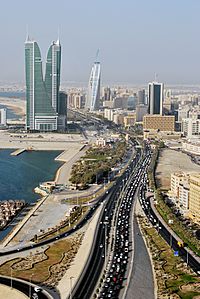
The biggest cities in Bahrain are:
- Manama - 154,700 people
- Riffa - 111,000 people
- Muharraq - 98,800 people
- Hamad Town - 57,000 people
- A'ali - 51,400 people
- Isa Town - 39,800 people
- Sitra - 37,100 people
- Budaiya - 33,200 people
- Jidhafs - 32,600 people
- Al-Malikiyah - 14,800 people
- Adliya
Other towns include: Awali, Diraz, Hidd, Sar, Bani Jamrah.
Economy
In Bahrain, making and processing petroleum (oil products) is very important. It makes up about 60% of the money from exports. It also provides 60% of the government's income and 30% of the country's Gross Domestic Product (GDP). The economy has changed as oil sales have changed since 1985. For example, this happened during and after the Persian Gulf War of 1990 - 1991.
Bahrain has good communication systems and transportation. Because of this, many international companies that do business in the Persian Gulf have offices there. A large part of Bahrain's money comes from petroleum products. These products are made from crude oil that is brought in from other places. Several big industrial projects are being built. Some main economic challenges are unemployment, especially for young people. Also, the amounts of oil and water resources are decreasing.
Geography
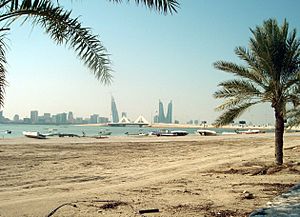
Bahrain is a flat and dry group of islands, called an archipelago. It has a low desert plain that gently rises to a small central hill. It is located in the Arabian Gulf, east of Saudi Arabia. The highest point is Jabal ad Dukhan ("Mountain of Smoke"), which is 122 meters high.
Bahrain has a total area of 620 square kilometers. This is a bit larger than the Isle of Man. Since it is an archipelago of 33 islands, Bahrain does not share land borders with any other country. It has a 161 km long coastline. Bahrain has mild winters and very hot, humid summers.
Bahrain's natural resources include large amounts of oil and natural gas, as well as fish. Only 1% of the country's land can be used to grow crops. About 92% of Bahrain is desert. The main natural dangers are droughts and dust storms.
Environmental problems in Bahrain include desertification. This is when land becomes desert, reducing the area where crops can grow. There is also damage to coastlines, coral reefs, and sea plants. This damage is caused by oil spills from large tankers and oil refineries.
People and Culture
The official religion of Bahrain is Islam. Most people are Shi'a and Sunni Muslims. However, there are also small Jewish and Christian groups. Most Bahrainis are Arabs. Some tribes originally came from Persia. Today, many people in Bahrain are guest workers. They come from places like Iran, South Asia, and Southeast Asia.
A newspaper article from 31 May 1983 said that Bahrain has many different religious and racial groups. Besides temporary workers, there are at least eight or nine different communities living on the island.
These groups include the Al-Khalifa family and Arab tribes connected to them. There are also the Baharnah (Shia Arabs) and the Howilla (Sunni Arabs from Persia). Other groups are Sunni Arabs from the mainland, Ajam (Persian Shia), and Indians who settled there long ago. There is also a small Jewish community and other groups.
Culture
Manama, Bahrain's capital city, is a modern city. But life in the many villages on the island, and even in some parts of Manama, is still very traditional. In the Persian Gulf area, tradition often means Islamic customs. For example, women often cover themselves from head to foot. Women visitors are expected to wear long skirts and one-piece bathing suits. About 85% of Bahrain's population is Muslim, and Islam is the official religion.
Arabic is the official language, but many people also speak English.
Traditional art forms are still practiced in Bahrain. Dhows (fishing boats) are built near Manama and Muharraq. Cloth is made at Bani Jamrah, and pottery is made at A'ali. A few goldsmiths still work in the Manama souk (market). However, much of this work is now done in other countries.
An important part of Bahraini culture is drinking traditional Arabian coffee. You can also find traditional Arabian street food like shawarma. This is lamb or chicken cut from a large spit and served in pita bread. Sweet treats like baklava are also popular.
Formula One
Bahrain is famous for hosting Formula One racing in the Middle East. It holds the Bahrain Grand Prix race.
Holidays
| Date | English Name | Local Name | Remarks |
|---|---|---|---|
| January 1 | New Year's Day | - | - |
| December 16 | National Day | - | - |
| December 17 | Accession Day | - | - |
| no set date | Feast of the Sacrifice or the Big Feast | Eid ul-Adha | Celebrates Abraham's willingness to sacrifice his son. It happens at the end of the month of hajj. |
| no set date | the Little Feast | Eid ul-Fitr | Celebrates the end of Ramadan. |
| no set date | Hijri New Year | Muharram | The Islamic New Year. |
| no set date | Al-Isra' ul-Miraj | - | Celebrates Muhammad's trip to heaven. |
| no set date | Prophet Muhammads birthday | Mawlid al-Nabi | - |
| no set date | Ashoura | death of imam Husain Al Shaheed (AS) | - |
Related Pages
Images for kids
-
A 1745 Bellin map of the historical region of Bahrain
-
The Persian Empire in the Sassanid era around 600 AD.
-
Facsimile of a letter sent by Muhammad to Munzir ibn-Sawa al-Tamimi, governor of Bahrain, in AD 628
-
The Portuguese Fort of Barém, built by the Portuguese Empire while it ruled Bahrain from 1521 to 1602.
-
Purple – Portuguese in the Persian Gulf in the 16th and 17th centuries. Main cities, ports and routes.
-
Greater flamingos (Phoenicopterus roseus) are native to Bahrain.
-
The King Fahd Causeway as seen from space.
-
The Bahrain national football team playing Australia on June 10, 2009, in a World Cup qualifier.
See also
 In Spanish: Baréin para niños
In Spanish: Baréin para niños




